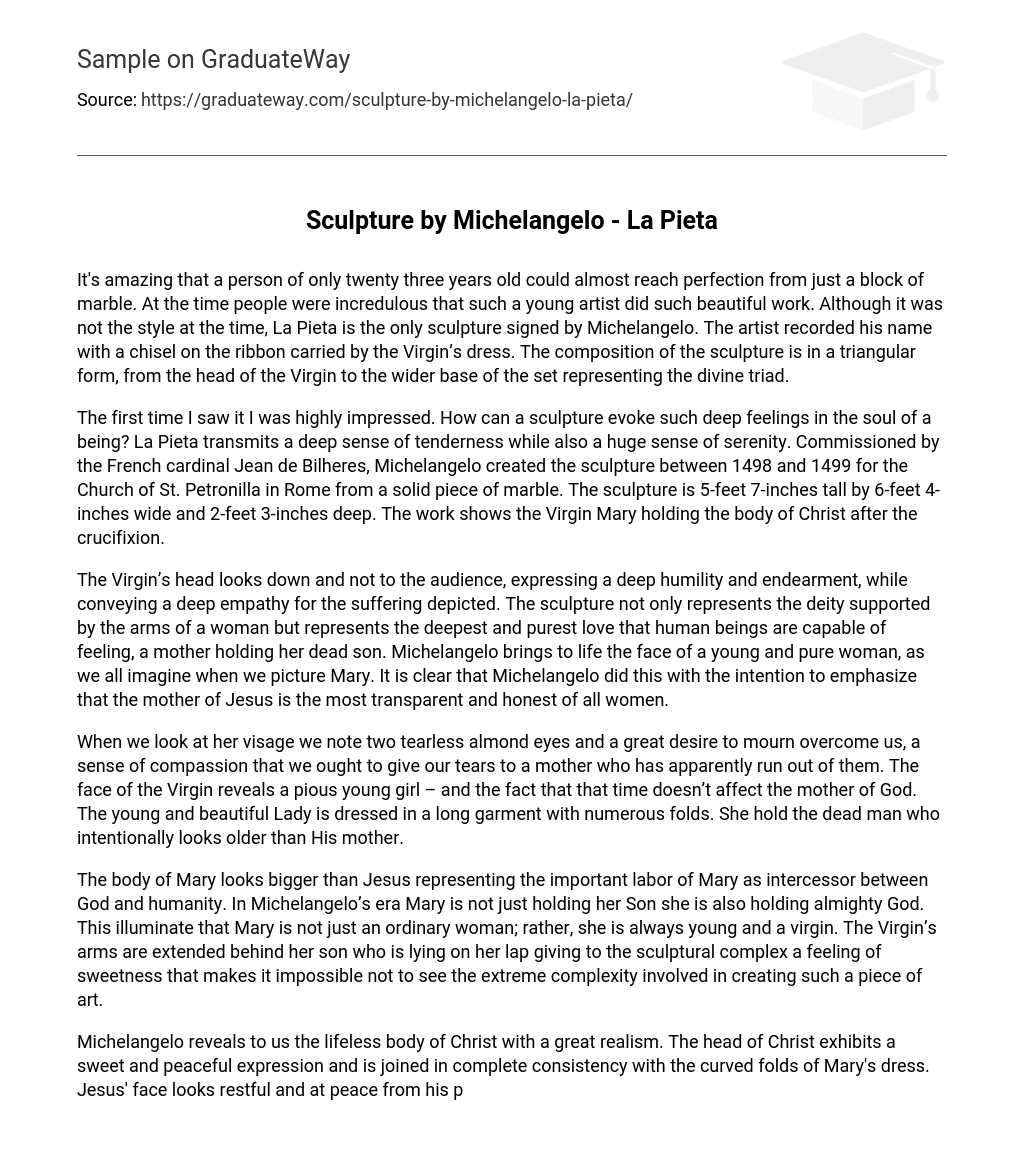It’s amazing that a person of only twenty three years old could almost reach perfection from just a block of marble. At the time people were incredulous that such a young artist did such beautiful work. Although it was not the style at the time, La Pieta is the only sculpture signed by Michelangelo. The artist recorded his name with a chisel on the ribbon carried by the Virgin’s dress. The composition of the sculpture is in a triangular form, from the head of the Virgin to the wider base of the set representing the divine triad.
The first time I saw it I was highly impressed. How can a sculpture evoke such deep feelings in the soul of a being? La Pieta transmits a deep sense of tenderness while also a huge sense of serenity. Commissioned by the French cardinal Jean de Bilheres, Michelangelo created the sculpture between 1498 and 1499 for the Church of St. Petronilla in Rome from a solid piece of marble. The sculpture is 5-feet 7-inches tall by 6-feet 4-inches wide and 2-feet 3-inches deep. The work shows the Virgin Mary holding the body of Christ after the crucifixion.
The Virgin’s head looks down and not to the audience, expressing a deep humility and endearment, while conveying a deep empathy for the suffering depicted. The sculpture not only represents the deity supported by the arms of a woman but represents the deepest and purest love that human beings are capable of feeling, a mother holding her dead son. Michelangelo brings to life the face of a young and pure woman, as we all imagine when we picture Mary. It is clear that Michelangelo did this with the intention to emphasize that the mother of Jesus is the most transparent and honest of all women.
When we look at her visage we note two tearless almond eyes and a great desire to mourn overcome us, a sense of compassion that we ought to give our tears to a mother who has apparently run out of them. The face of the Virgin reveals a pious young girl – and the fact that that time doesn’t affect the mother of God. The young and beautiful Lady is dressed in a long garment with numerous folds. She hold the dead man who intentionally looks older than His mother.
The body of Mary looks bigger than Jesus representing the important labor of Mary as intercessor between God and humanity. In Michelangelo’s era Mary is not just holding her Son she is also holding almighty God. This illuminate that Mary is not just an ordinary woman; rather, she is always young and a virgin. The Virgin’s arms are extended behind her son who is lying on her lap giving to the sculptural complex a feeling of sweetness that makes it impossible not to see the extreme complexity involved in creating such a piece of art.
Michelangelo reveals to us the lifeless body of Christ with a great realism. The head of Christ exhibits a sweet and peaceful expression and is joined in complete consistency with the curved folds of Mary’s dress. Jesus’ face looks restful and at peace from his previous affliction. His corpse looks serene, perhaps reflecting that his work and mission on earth were over. His right arm falls perfectly inert opposite his mother’s left arm, which is full of life and commiseration. His hands are pierced, evidencing his past passion on the cross.
La Pieta does not show us the pain of the mother or the agony of the tortured Christ. La Pieta shows us again and again how life and death draw together in humanity. La Pieta shows us how a person’s love goes beyond the borders of death. It shows how love can break barriers of race or gender. No matter what religion we practice, one can admire such a piece of art. La Pieta represents the most sublime and pure love that human beings are capable of expressing. La Pieta can move us to feel a peace that seems as serene as the divine perfection depicted.





